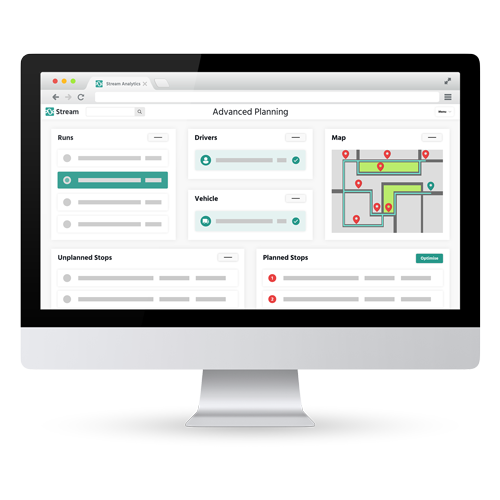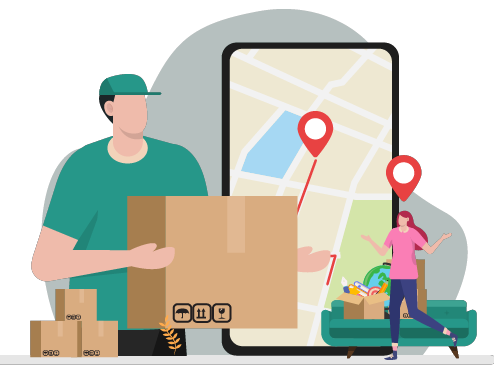We’ve all used Google Maps, Waze, Apple Maps, or any number of other satellite navigation applications to get us from point A to point B, without having to go through the hassle of manually planning or optimising a set route.
Most cars now come with this type of software as standard, usually assessed using a touchscreen console, but not all route optimisation software offers the functionality that logistics operations require.
Using physical maps and having logistics teams laboriously planning out drop-off points along a set delivery route are now a product of a bygone era, for those that embrace the technology to do so.

In this post we’ll be outlining what route optimisation is, the various factors that route planning and optimisation software have to account for.
We’ll also be highlighting the key benefits of using route optimisation too, which should help you better understand what the technology is all about, and whether it merits investment.
Defining route optimisation
Route optimisation is the process of finding the most efficient route for a given stop, or set of multiple stops, and is most beneficial for operations within the transport and logistics industries, particularly for businesses that utilise their own fleet of vehicles and deliver or collect goods in those vehicles.
There are a number of factors that can be considered by (most) route optimisation software when calculating a journey:
- The number and location of stops
- The time windows for deliveries or collections (plus delivery or collection slots)
- The distance between stops
- The traffic conditions
- The vehicle’s fuel efficiency
- The driver’s preferences
- The vehicle itself and road compliance
And these factors are calculated using a variety of methods, including mathematical algorithms, heuristics, and machine learning. Once calculated, the route is then displayed on a device, and navigation is offered (typically on a smartphone or rugged mobile device) for a driver to use as navigation.

The benefits of route optimisation
There are a number of key benefits that route optimisation can provide to logistics operations:
- Save time and reduce workloads: Drivers and planners no longer need to spend significant time planning out and optimising routes, route optimisation software, like Stream, automatically produces the most economical delivery or collection route, which can be edited as seen fit, by a Transport planner for example, offering customisation and flexibility.
- Reduce costs: It helps businesses save money on fuel costs and vehicle maintenance, while reducing the likelihood of drivers having to work overtime.
- Boost customer satisfaction: It boosts customer satisfaction by ensuring delivery times are adhered to and by increasing the likelihood of successful, on-time deliveries.
- Increase efficiency: It can help businesses increase their efficiency by reducing the amount of time and fuel that’s wasted on unnecessary travel, which is particularly necessary in competitive industries and with current levels of inflation.
- Increase compliance with DVSA legislation and road regulations: By law, specific commercial vehicles can only use certain roads. Turn (which can be used alongside Stream), for example, provides route navigation for your commercial vehicles based on its exact dimensions, to ensure you’re never taken down the wrong roads.
Why Stream does route planning and optimisation best
Route planning and route optimisation are tantamount to one another; without one, there would not be the other.
Stream’s intelligent route planning and route optimisation software helps you plan, optimise, and schedule the most efficient delivery and collection routes in just a few clicks, but there are additional functionalities that competitors tend to lack that are worth considering if you’re looking to invest in a route optimisation software.

Multi-drop/multi-depot functionality
More complex and feature-rich route optimisation software like Stream also offers multi-drop, multi-depot, and multi-vehicle routes to ensure the best possible utilisation across your fleet. This includes the ability to plan overnight stops at these locations too.
Custom route optimisation features for milk runs
Many businesses use fixed routes, or ‘milk runs’, and deliver to the same customers, drop-off points, and collection points on a recurring (often daily) basis. Stream also enables you to consolidate your collections and deliveries into a single run, so you can reduce the number of vehicles you need out on the roads, which brings a host of benefits.
You also have the ability to easily re-optimise those routes as you add or remove customers from established milk runs, and add individual deliveries and/or collections that are near or on those routes. This offers a level of flexibility not frequently available for route planning and optimisation software.
Can Google Maps, Waze or Apple Maps optimise delivery routes?
Software like Google Maps, Waze and Apple Maps aren’t built specifically for optimising delivery routes, so they lack a number of features that a purpose-built software like Stream has to offer, particularly when it comes down to the planning aspect of deliveries.
Although good for getting a person from point A to point B as efficiently as possible, they don’t offer the same level of multi-stop planning and route optimisation as Stream, where numerous variables, such as multiple delivery slots for imported orders and trunk runs can be factored in and fine-tuned up until the vehicle departs on the run.
“We have been using Stream for a couple of years now and the way we are kept updated with our routes is better than any other delivery software.”
Sanctuary Bathrooms
Read more about what our loyal subscribers have to say about us here.
Optimise your delivery routes with Stream
Speak to one of our experts to find out more about optimising routes with Stream, as well as other key features such as real-time delivery tracking, electronic Proof of Delivery (ePOD), and order management.
Frequently Asked Questions
Route optimisation is the process of finding the most efficient route for a given stop, or set of multiple stops, and it is most beneficial for operations within the transport and logistics industries, particularly for businesses that utilise their own fleet of vehicles and deliver or collect goods in those vehicles.
The benefits of optimising routes are numerous, including: saving time and costs, reducing workloads, enhancing efficiency, boosting customer satisfaction and increasing compliance with DVSA legislation and road regulations. These benefits justify the cost of investing in a feature-rich transport and logistics software that offers route optimisation as standard.







